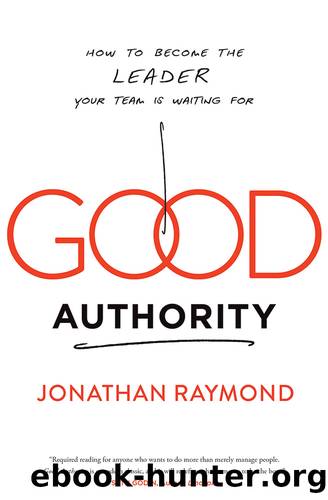Good Authority by Jonathan Raymond

Author:Jonathan Raymond [Raymond, Jonathan]
Language: eng
Format: epub
ISBN: 9781940858197
Publisher: Ideapress
Published: 2016-09-06T05:00:00+00:00
Learning to see accountability as a tool to help people own their strengths, rather than point out their weaknesses, is the essence of Good Authority. We get there first by changing our worldview, in all the ways youâve read up to this point. And what will inspire us to change our worldview is a clear experience of the benefits. Our job as managers is to show our teams the personal benefits of changing, by focusing intently on how they relate to their work, and how that can translate into the rest of their lives. With all the noise and confusion that surrounds us when it comes to company culture and employee/manager engagement, itâs this kind of accountability that gives us a way through to the heart of things.
Before we go step by step through how to put this new mode of accountability into practice, we should spend a minute talking about how accountability is most likely happening now in your organization: Chances are itâs coming far too late in the employee development cycle, which results in a pattern weâve come to call spontaneous management combustion.
Hereâs what that pattern looks like: You hire someone. You hope that theyâre going to fill the gap youâre seeing on your team. Usuallyâapart from the rare true mis-hireâthey do some things well out of the gate. But while theyâre doing some things well, you start to see their limitations. Sometimes it takes a few months, but itâs usually sooner than that. Some part of it is a skills limit: They donât know everything you hoped that they would. Thatâs a real problem that needs to be dealt with through additional training on and off the job, but itâs not the problem that has the biggest impact on the team and on the culture as a whole.
The bigger problem youâre seeing is in their relationship to their work. Or, more specifically, how they respond to the challenge of not knowing what they donât know. Here are a few patterns you may have seen that indicate the person youâre managing is avoiding their next step of growth: covering up or attempting to brush off the severity of a mistake; hoarding data; embedding themselves as a go-to person (aka: bottleneck) by creating a system or process that only they know how to use; resorting to quick fixes instead of asking questions and looking for root causes; asking for more time or resources beyond what was agreed on in order to complete a project, instead of coming to you to talk about what went wrong so you can work together to improve it; letting tension build with a teammate or between departments instead of coming to you for advice on how to handle it.
When you lack the skills to intervene, to name the dysfunctional behaviors and help people grow beyond them, these problems fester and expand. You start wondering whether someone is a fit before youâve taken real action to poke around and find out. You hear the soft complaints from other members of the team but brush them off.
Download
This site does not store any files on its server. We only index and link to content provided by other sites. Please contact the content providers to delete copyright contents if any and email us, we'll remove relevant links or contents immediately.
| Ethics | Etiquette |
| Fashion & Image | Health & Stress |
| Motivation & Self-Improvement | Work Life Balance |
| Workplace Culture |
Tools of Titans by Timothy Ferriss(8307)
Change Your Questions, Change Your Life by Marilee Adams(7689)
Deep Work by Cal Newport(6969)
Playing to Win_ How Strategy Really Works by A.G. Lafley & Roger L. Martin(6089)
Man-made Catastrophes and Risk Information Concealment by Dmitry Chernov & Didier Sornette(5958)
Digital Minimalism by Cal Newport;(5707)
Big Magic: Creative Living Beyond Fear by Elizabeth Gilbert(5681)
The Slight Edge by Jeff Olson(5379)
Ego Is the Enemy by Ryan Holiday(5350)
The Motivation Myth by Jeff Haden(5176)
The Laws of Human Nature by Robert Greene(5087)
Stone's Rules by Roger Stone(5053)
Tuesdays with Morrie by Mitch Albom(4733)
Eat That Frog! by Brian Tracy(4484)
Rising Strong by Brene Brown(4414)
Skin in the Game by Nassim Nicholas Taleb(4206)
Bullshit Jobs by David Graeber(4143)
The Money Culture by Michael Lewis(4138)
Skin in the Game: Hidden Asymmetries in Daily Life by Nassim Nicholas Taleb(3962)
